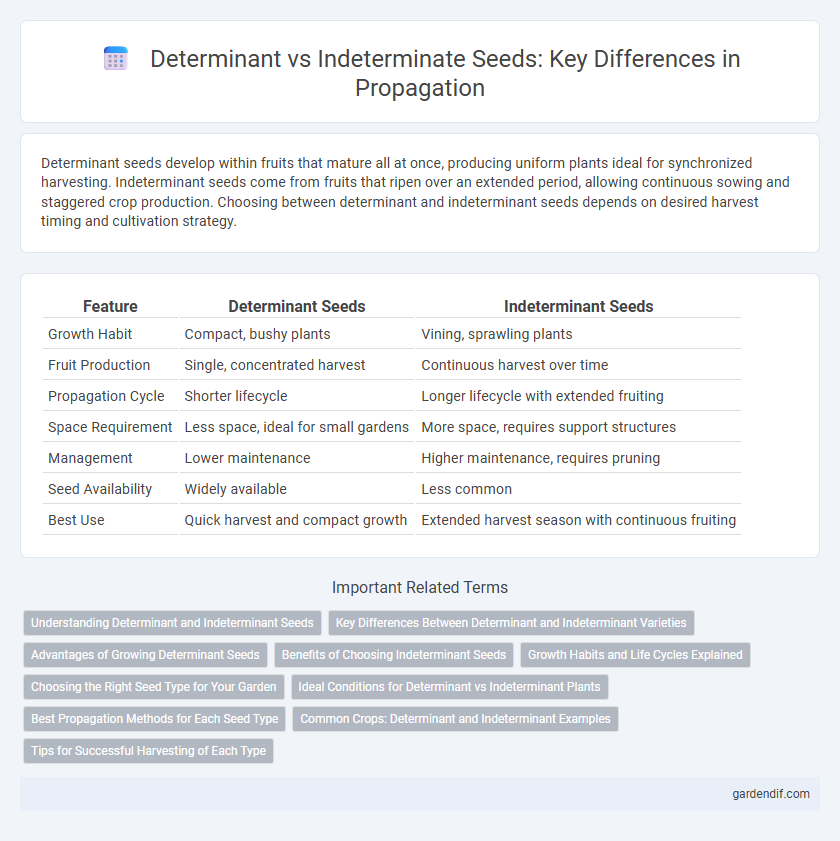
Determinant Seeds vs Indeterminant Seeds Illustration
Determinant seeds develop within fruits that mature all at once, producing uniform plants ideal for synchronized harvesting. Indeterminant seeds come from fruits that ripen over an extended period, allowing continuous sowing and staggered crop production. Choosing between determinant and indeterminant seeds depends on desired harvest timing and cultivation strategy.
Table of Comparison
| Feature | Determinant Seeds | Indeterminant Seeds |
|---|---|---|
| Growth Habit | Compact, bushy plants | Vining, sprawling plants |
| Fruit Production | Single, concentrated harvest | Continuous harvest over time |
| Propagation Cycle | Shorter lifecycle | Longer lifecycle with extended fruiting |
| Space Requirement | Less space, ideal for small gardens | More space, requires support structures |
| Management | Lower maintenance | Higher maintenance, requires pruning |
| Seed Availability | Widely available | Less common |
| Best Use | Quick harvest and compact growth | Extended harvest season with continuous fruiting |
Understanding Determinant and Indeterminant Seeds
Determinant seeds come from plants with a predetermined growth pattern, meaning they stop growing once a certain size or stage is reached, leading to a synchronized seed maturation which aids in uniform harvesting. Indeterminant seeds originate from plants that continue to grow and produce seeds throughout the season, providing extended seed collection periods but less uniformity in seed maturity. Understanding these differences allows growers to select seed types that best fit their planting schedules, climate conditions, and harvest goals.
Key Differences Between Determinant and Indeterminant Varieties
Determinant seeds come from plants that grow to a fixed size and produce fruit all at once, making them ideal for controlled harvest schedules, while indeterminant seeds originate from plants that grow continuously and yield fruit over a prolonged period. Key differences include growth habit, with determinant varieties being bushier and compact, whereas indeterminant types are vining and require more space and support. Determinant seeds typically have a shorter maturation time, suited for early-season planting, while indeterminant seeds support extended harvest windows, enhancing yield potential across multiple seasons.
Advantages of Growing Determinant Seeds
Determinant seeds produce plants that grow to a predefined size and mature simultaneously, allowing for predictable harvest times and uniform crop management. These seeds are ideal for commercial farming due to their consistent yield and reduced labor requirements. The controlled growth patterns of determinant seeds also minimize the risk of overgrowth and improve resource efficiency.
Benefits of Choosing Indeterminant Seeds
Indeterminant seeds offer extended flowering periods, allowing continuous harvests and increased yields compared to determinant seeds with fixed growth cycles. Their adaptability to varying environmental conditions makes indeterminant seeds ideal for staggered propagation and maximizing plant productivity. Choosing indeterminant seeds supports flexible cultivation schedules and sustained resource efficiency in seed propagation.
Growth Habits and Life Cycles Explained
Determinant seeds produce plants with a fixed growth habit, where the main stem terminates in a flower cluster, leading to a defined life cycle and predictable crop duration. Indeterminant seeds result in plants that continue to grow and produce flowers along the stem, extending the life cycle and allowing ongoing harvests over time. Understanding these growth habits is essential for optimizing planting schedules and crop management in both commercial and home gardening.
Choosing the Right Seed Type for Your Garden
Selecting the right seed type for your garden depends on growth habits and harvest goals. Determinant seeds produce plants with a fixed size and a single, concentrated fruiting period, ideal for gardeners seeking a uniform, manageable crop. Indeterminant seeds yield plants that continue growing and producing fruit throughout the season, providing extended harvests and flexibility for gardeners with longer growing periods.
Ideal Conditions for Determinant vs Indeterminant Plants
Determinant plants thrive in controlled environments with consistent light and temperature, promoting simultaneous seed development within a fixed growing period. Indeterminant plants require variable conditions with extended daylight and moderate temperatures to support continuous flowering and prolonged seed production. Optimizing soil moisture and nutrient levels benefits both, but timing and environmental stability are crucial for determinant versus ongoing growth in indeterminant varieties.
Best Propagation Methods for Each Seed Type
Determinant seeds benefit most from propagation methods like direct sowing and container planting, which support their limited growth period and synchronized fruiting. Indeterminant seeds thrive with techniques such as succession planting and trellis support, allowing continuous growth and extended harvest times. Optimizing seed type-specific propagation enhances yield efficiency and plant health.
Common Crops: Determinant and Indeterminant Examples
Determinant seeds, common in crops like bush beans and determinate tomatoes, produce plants that grow to a fixed size and mature all their fruit simultaneously, facilitating concentrated harvests. Indeterminant seeds, found in crops such as pole beans and indeterminate tomatoes, lead to plants that continue growing and producing fruit throughout the season, offering extended yields. Understanding these growth patterns aids in selecting the right crop type for specific farming goals and harvesting schedules.
Tips for Successful Harvesting of Each Type
Determinant seeds produce fruit all at once, so timing the harvest precisely is essential to avoid overripe produce; monitor plant maturity and harvest within a narrow window for optimal quality. Indeterminant seeds yield fruit continuously over time, requiring frequent checks to pick ripe fruits regularly and encourage ongoing production. Using proper tools and handling techniques minimizes damage, preserving seed viability and ensuring successful subsequent propagation.
Determinant Seeds vs Indeterminant Seeds Infographic

 gardendif.com
gardendif.com